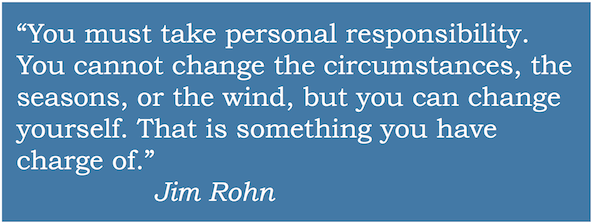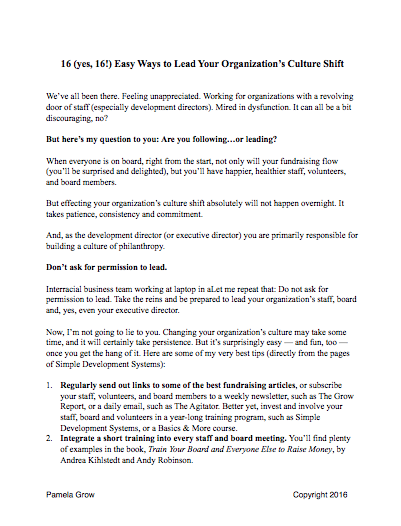We’ve all been there. Feeling unappreciated. Working for organizations with a revolving door of staff (especially development directors). Mired in dysfunction. It can all be a bit discouraging, no?
But here’s my question to you: Are you following…or leading?
When everyone is on board, right from the start, not only will your fundraising flow (you’ll be surprised and delighted), but you’ll have happier, healthier staff, volunteers, and board members.
 But effecting your organization’s culture shift absolutely will not happen overnight. It takes patience, consistency and commitment.
But effecting your organization’s culture shift absolutely will not happen overnight. It takes patience, consistency and commitment.
And, as the development director (or executive director) you are primarily responsible for building a culture of philanthropy.
Don’t ask for permission to lead.
 Let me repeat that: Do not ask for permission to lead (hey, that’s a tweetable!). Take the reins and be prepared to lead your organization’s staff, board and, yes, even your executive director.
Let me repeat that: Do not ask for permission to lead (hey, that’s a tweetable!). Take the reins and be prepared to lead your organization’s staff, board and, yes, even your executive director.
Now, I’m not going to lie to you. Changing your organization’s culture may take some time, and it will certainly take persistence. But it’s surprisingly easy — and fun, too — once you get the hang of it. Here are some of my very best tips (directly from the pages of Simple Development Systems):
- Regularly send out links to some of the best fundraising articles, or subscribe your staff, volunteers, and board members to a weekly newsletter, such as The Grow Report, or a daily email, such as The Agitator. Better yet, invest and involve your staff, board and volunteers in a year-long training program, such as Simple Development Systems, or a Basics & More course.
- Integrate a short training into every staff and board meeting. You’ll find plenty of examples in the new book, Train Your Board and Everyone Else to Raise Money, by Andrea Kihlstedt and Andy Robinson.
- I’ve found it helpful to ask a program staff member their advice on an appeal letter, for the simple reason that a.) people love it when you ask their advice, and b.) it’s a lesson in the importance of story gathering.
- When you receive special “thank yous” from clients, copy them and send them on to board members.
- Show gratitude regularly. Utilize a company like Send Out Cards, or keep a desk drawer full of inexpensive cards (Trader Joe’s has a nice line), to send Birthday, Anniversary or “just because” cards to your board members.
- Schedule regular ‘Thank-a-Thons,’ where your board members pen hand-written thank you notes, or make thank you phone calls to donors. Make it a fun experience by scheduling 20-30 minutes within the course of a board meeting and serving refreshments.
- Spend one-on-one time with your board members getting to know them individually. Find out their stories — why did they get involved?
- Take a photo of the work your organization does, capturing progress in pictures. Then, send or hand-deliver the photo and tell the donor. (via Veritus)
- Get your CEO or Executive Director to write a handwritten note to your “A” level donors, saying how much their support is making a difference. (via Veritus)
- Some call them ‘mission moments:’ At every staff and board meeting share your latest “story,” whether it’s about one of your agency’s clients or about a donor or even about a recent visitor to your organization. Encourage staff members to share their stories.
- Shadow a member of your program staff for several hours or even a day. Better yet, invite program staff to donor and foundation visits!
- Invite donors into your organization. Not just for the usual guided tours…think about inviting a donor to your regular board or staff meetings (and definitely think about including a donor on your board). Most importantly, invite them to share their perspective.
- Install a ‘share-your-story’ page on your organization’s website. Regularly direct your donors and supporters to it by way of your emails and social media.
- Think outside of the proverbial box. Recently I attended a United Way branding workshop on behalf of a client. Among the participants, I was delighted to learn that one organization had sent program staff in lieu of marketing or development staff. I spent some time chatting with them and it was clearly an eye-opening experience for them in terms of how they could better share their clients’ stories with their development department.
- Does 100% of your board contribute financially? You’ll need to find out what works best for you, but I have found that speaking with board members on an individual basis typically yields far better results. Starting your monthly giving with your board members is also a great way to both introduce monthly giving, and encourage your board members to stretch their gift. You’ll find some great tools featured in this article, including a sample board-giving letter in case you’re stumped.
- Create a habit of celebrating every little success. When you reach 100% board participation, celebrate it! When your retention rate climbs over 60%, celebrate it! Perhaps with a pizza party at your next board meeting, or by breaking out a bottle of champagne. A board member has brought in three new donors? Send them a thank you gift or present a token of your gratitude publicly at your next board meeting. Remember to have fun and “Celebrate what you want to see more of.” (Tom Peters)
Is that all? Nope. Know your organization’s numbers, know your retention rate, and educate your staff and board.
You know how to do this.
And you owe it to your organization to step up to your leadership and be the change. How are you leading your organization’s culture shift?
Download this article:


















 I can’t wait to meet with you personally.
I can’t wait to meet with you personally.
Comments on this entry are closed.